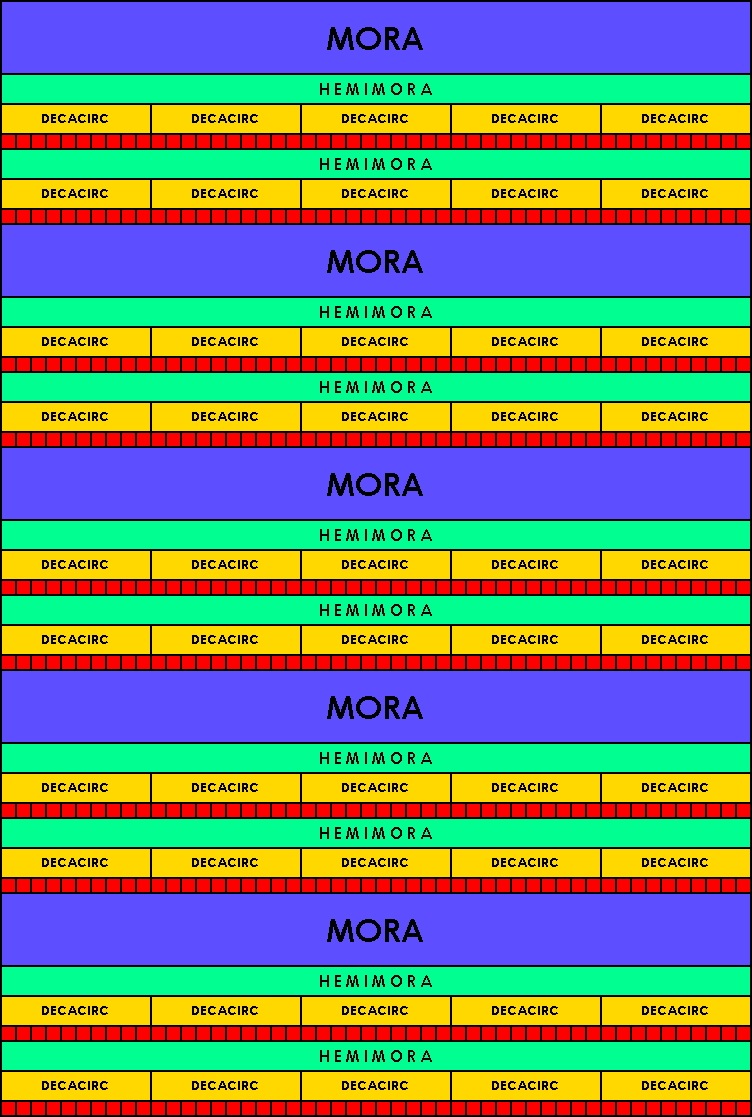Hydrogen Standard
Hydrogen Time: Logarithmic Units
This conversion table has been configured to convert between Hydrogen Time Logarithmic (H.T.) Units and Standard Metric Time (S.M.T.) Units. S.M.T. conversion values are presented in base-ten numerics and rounded to three decimal places, as the ratio between the S.M.T. base unit (second) and the H.T. base unit (hydrogen gigacycle) is 1:1.420405752, an irrational decimal. H.T. unit names are given in Standard English.
| H.T. Unit | Abbrev. | Comparative Value | S.M.T. Unit |
|---|---|---|---|
| nanochron | nc | 1 hydrogen valence cycle | 0.704 nanosecond |
| microchron | mcc | 1000 hydrogen valence cycles | 0.704 microsecond |
| millichron | mlc | 1e6 hydrogen valence cycles | 0.704 millisecond |
| chron | c | 1e9 hydrogen valence cycles | 0.704 second |
| kilochron | kc | 1000 c | 704.024 seconds / 11.734 minutes |
| mirakilochron | mikc | 10 kc / 10000 c | 7040.242 seconds / 117.337 minutes |
| magnakilochron | makc | 100 kc / 100000 c | 19.556 hours |
| megachron | mgc | 1000 kc | 195.562 hours / 8.148 days |
| miramegachron | mimgc | 10 mgc | 1955.623 hours / 81.4842806 Earth days |
| magnamegachron | mamc | 100 mgc | 814.843 days / 2.232 years |
| gigachron | gc | 1000 mgc | 8148.428 days / 22.324 years |
| terachron | tc | 1000 gc | 22324.460 years |
| petachron | pc | 1000 tc | 22324460.400 years |
| mirapetachron* | mipc | 10 pc | 223244604 years |
| exachron† | xc | 1000 pc | 22324460400 years |
†An exachron is longer than the current age of the universe.
Hydrogen Time: Convenience Units
This conversion table has been configured to convert between Hydrogen Time Convenience (H.T.) Units and Standard Metric Time (S.M.T.) Units. S.M.T. conversion values are presented in base-ten numerics and rounded to three decimal places, as the ratio between the S.M.T. base unit (second) and the H.T. base unit (hydrogen gigacycle) is 1:1.420405752, an irrational decimal. H.T. unit names are given in Standard English.
| H.T. Unit | Abbrev. | Comparative Value | S.M.T. Unit |
|---|---|---|---|
| chron | c | 1/100 ty | 0.704 seconds |
| tychon | ty | 100 c | 70.402 seconds |
| arc | arc | 50 ty | 58.669 minutes |
| hemicirc | hcrc | 10 arc | 9.778 hours |
| circ | crc | 2 hcrc / 20 arc | 19.556 hours |
| decacirc | dcrc | 10 crc | 8.148 days |
| hemimora | hmra | 5 dcrc / 50 crc | 40.742 days |
| mora | mra | 10 dcrc / 100 crc | 81.484 days |
| annua | ann | 5 mra / 500 crc | 407.421 days / 1.1162 years |
| decana | dann | 10 ann | 11.162 years |
| centana | cann | 100 ann | 111.622 years |
| kilana | kann | 1000 ann | 1116.223 years |
| epoch | epc | 1000000 ann | 1116223 years |
| eon | eon | 1000000000 ann | 1116223000 years |
Time and Date
The calendar of a standard annua is set up in the manner shown below: five moras, two hemimoras to one mora, five decacircs to one hemimora, ten circs to one decacirc. These units are not named; only numbered. Moras number 1-5; hemimoras number 1-10 per year or 1-2 per mora; decacircs number 1-10 per mora or 1-5 per hemimora; days number 1-10 per decacirc or 1-50 per hemimora.
5/8/3/11608 UME
15:36:82



Comments